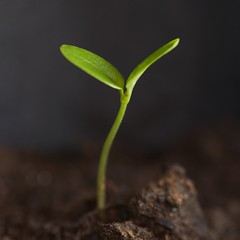It’s Spring and It’s Time to Start Your Seeds
It doesn’t matter if your seeds are for flowers or the  vegetable garden.
vegetable garden.
Now is the time.
Start them inside until you’re past the last frost date in your area. For my area, it’s May 15 for any tender crops to be safely planted outside. If the little seedlings go out too early, you may run the risk of losing your young plants to a late frost. Then again, maybe you’ll get lucky…
The following video offers some tips on starting your seeds.
Starting Seeds
(An excerpt from Purdue University Cooperative Extension Service – Source here)
The proper time for sowing seeds depends upon when plants may normally be moved outdoors. The periods range from 4 to 14 weeks, depending upon the speed with which seedlings grow and the conditions in the home. Read the label on the seed packet for any planting directions.
1. Fill the container to within 3/4 inch from the top with the mixture to be used. If it is dry, moisten the mixture before filling. Make sure that the container has adequate drainage. Before filling, cover holes or cracks in the container with sphagnum moss or broken crockery.
2. Level and gently firm the planting medium. Use a clean small board for leveling and firming. Do not press too hard in firming the surface or poor aeration and decreased root growth will result.
3. Make shallow rows about 1-2 inches apart in the flat using a narrow board or large wooden marker label. When different seeds are used in the same container, they are easier to keep track of if planted in rows. If only one type of seed is used in each flat, then seed may be scattered or broadcast over the surface.
4. Sow seeds uniformly and thinly in the rows. Many small, round seeds may be slowly dropped into the rows by tapping the package as it is held over the rows. Label each row promptly with plant type, variety, and date of planting. Use pencil or waterproof pen for labeling.
Plant large seeded vegetables, such as cucumber, muskmelon, and watermelon, directly into peat pots. Other seeds may also be handled this way to save transplanting, but sowing is difficult with very small seeds. Plant two seeds per pot and later thin to one plant. This saves later transplanting and means less root damage at planting time.
5. Cover the seeds with dry vermiculite or milled sphagnum moss. The depth of covering depends upon the size of the seeds. Very fine seeds, such as petunia or begonia, should not be covered. Moisten the surface with a fine mist, or place the container in a pan of warm water to absorb moisture from the base. Do not place containers in water that is deep enough to run over the top of the pot or flat. It may mix seeds or cover them too deeply. Bottom watering helps avoid damping off by keeping the soil surface dry. As a general rule, seeds other than very fine seeds should be covered with soil to a depth of about two times their diameter.
6. Cover the container with polyethylene plastic film (a clear bag will do) or a piece of window glass. Since they retain moisture, no additional watering should be necessary until after seeds have germinated.
7. Place seeds in a warm location for germination. Generally a temperature range of 65-75°F (18-24°C) is best. A few plants, such as larkspur, snapdragon, sweet pea, cabbage, broccoli, and cauliflower, are best started at about 55°F (13°C). Do not place covered containers in direct sunlight.
8. Watch daily for germination. Move to bright light, and remove plastic or glass coverings as soon as germination is well underway. If all seeds do not germinate at the same time, cut strips of plastic or cloth and keep ungerminated rows covered until seedlings appear. Seeds are quickly killed if allowed to dry during germination. Watch closely for development of damping-off, and control promptly. After germination, place those plants listed as preferring cool temperatures in cool location.
Get the full PDF here You’ll find it to be a pretty useful article.
Hope this is helpful.
Feel free to LEAVE A COMMENT below and PLEASE SHARE!!!
Thanks for reading.


